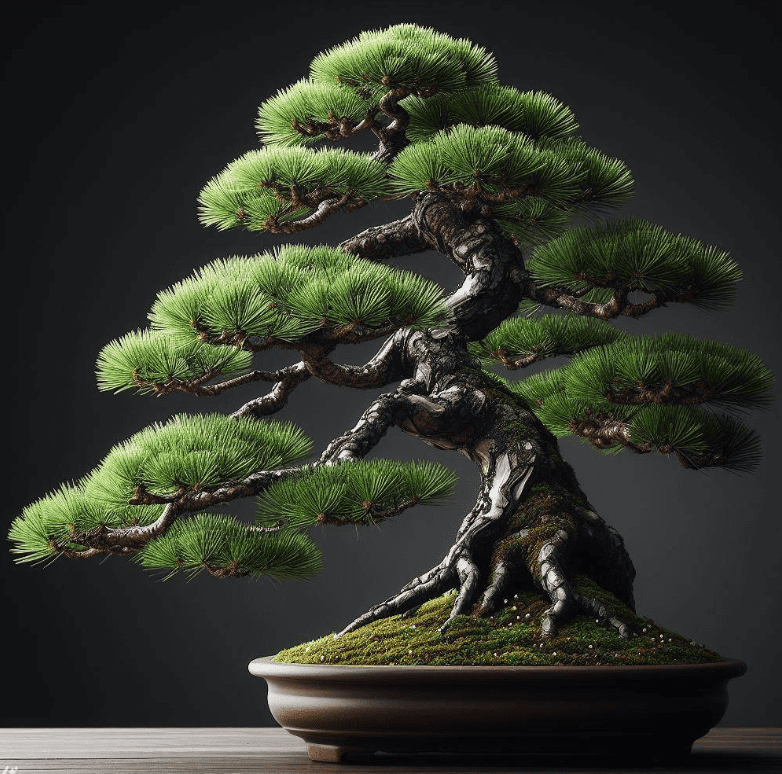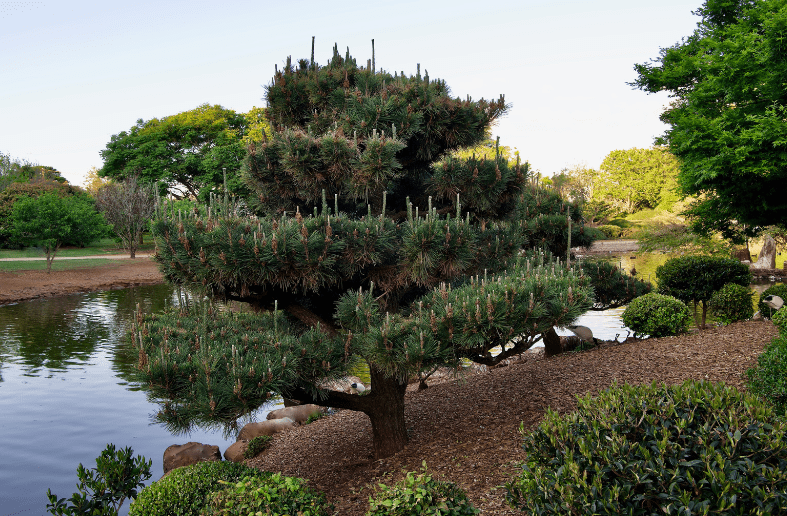
The Japanese black pine (Pinus thunbergii) is a stunning evergreen tree that has captured the hearts of many landscape enthusiasts and bonsai artists alike.
Why Grow a Japanese Black Pine?
There are many reasons to consider adding a Japanese black pine to your home or garden. Here are just a few of the benefits:
- Versatility: The Japanese black pine can be grown in various climates, from hot to dry. It can also thrive in sandy, clay, and even rocky terrain.
- Durability: This hardy tree resists pests, diseases, and salt spray. It can also withstand strong winds and occasional droughts.
- Aesthetics: The Japanese black pine has a beautiful shape and foliage. Its needles are dark green and needle-like, and its branches can be trained into various shapes, making it a popular choice for bonsai artists.
What You’ll Learn
This comprehensive guide will explore everything you need about growing and caring for a Japanese black pine. From choosing the suitable variety and selecting the perfect planting location to pruning, fertilizing, and protecting your tree from pests and diseases, we will cover all the essential aspects of tree care.
Choosing the Right Variety
There are many different varieties of Japanese black pine, each with unique characteristics.
Some popular varieties include:
-
Nana: This dwarf variety is perfect for bonsai and indoor cultivation.
-
Shohin: This even smaller variety is ideal for the most experienced bonsai enthusiasts.
-
Seijo: This variety has a more open growth habit and is a good choice for large-scale landscapes.
-
Shoshoni: This variety has a more weeping or pendulous growth habit and is a good choice for creating a cascading effect.
Selecting the Perfect Planting Location
When choosing a planting location for your Japanese black pine, it is essential to consider the following factors:
-
Sunlight: Japanese black pines prefer full sun but can also tolerate partial shade.
-
Water: Japanese black pines need regular watering but are also drought-tolerant.
-
Soil: Japanese black pines prefer well-drained, sandy soil.
-
Wind: Japanese black pines are relatively wind-tolerant.

Pruning and Shaping
Japanese black pines are relatively easy to prune and shape. The best time to prune is in the winter or early spring when the tree is dormant. You can use hand pruners or loppers to prune the branches and wire to shape the trunk and branches.
Fertilizing
Japanese black pines need regular fertilization to maintain their health and vigor. You can use a balanced or formulated fertilizer for pine trees. Fertilize in the spring and fall, and avoid fertilizing in the winter.
Protecting from Pests and Diseases
Japanese black pines are generally resistant to pests and diseases. However, they can be affected by spider mites, aphids, and scale insects. You can treat these pests with insecticidal soap.
Growing a Japanese Black Pine as a Bonsai
Japanese black pines are a popular choice for bonsai because they are relatively easy to care for and can be trained into various shapes. To grow a Japanese black pine as a bonsai, you must start with a young tree and carefully prune and shape it over time.

Selecting a Bonsai Pot
The first step in growing a Japanese black pine as a bonsai is to select the right pot. The pot should be slightly wider than the root ball of the tree and should have drainage holes to allow water to escape. You can use a ceramic pot, a plastic pot, or even a wooden box.
Repotting
Japanese black pines must be repotted every few years to prevent the roots from becoming pot-bound. When repotting, choose a pot about 1 inch larger than the current pot. Fill the pot with a well-draining soil mixture, and place the tree in the center of the pot. Tamp the soil down firmly and water thoroughly.
Pruning
Pruning is an integral part of bonsai care, as it helps to shape the tree and control its growth. You can prune the tree during the winter or early spring when the tree is dormant. Use sharp pruners or loppers to remove unwanted branches and to shape the tree.
Wiring
Wiring can be used to shape the branches of the tree further. Use a soft, flexible wire to bend the branches into the desired position gently. Leave the wire on the tree for several months to allow the branches to harden in their new shape.
Watering
Japanese black pines need to be watered regularly, but they should not be allowed to sit in soggy soil. Water the tree thoroughly when the top inch of soil feels dry. In the winter, you may need to water less frequently, as the tree will be dormant.
Fertilizing
Fertilize your bonsai tree every two to three weeks during the growing season. Use a balanced fertilizer formulated explicitly for bonsai trees.
Overwintering
If you live in an area with cold winters, you must bring your bonsai tree indoors to protect it from frost. Place the tree in a cool, well-lit location. Water the tree less frequently in the winter, as it will not grow actively.

Caring for a Japanese Black Pine Bonsai
Caring for a Japanese black pine bonsai can be a rewarding and enjoyable hobby. With proper care, your bonsai tree can live for many years and become a cherished part of your home or garden.
Additional Tips:
-
Monitor the humidity level around your bonsai tree. Japanese black pines prefer high humidity, so you may need to mist the leaves regularly or place the pot on a tray of pebbles filled with water.
-
Avoid using harsh chemicals on your bonsai tree. If you are infested with pests or diseases, use organic or natural remedies instead of harsh insecticides or fungicides.
-
**Be patient. It takes time and practice to grow a beautiful bonsai tree. Don’t get discouraged if your tree doesn’t look perfect right away. Just keep practicing and learning, and you will eventually achieve the results you are looking for.
Maintaining Your Japanese Black Pine’s Majesty: Troubleshooting and Beyond
Conquering Common Challenges:
While hardy, even a resilient Japanese black pine might face issues. Here’s how to navigate some common challenges:
Needle Discoloration:
-
Yellowing needles can indicate overwatering, nutrient deficiency, or root rot. Check watering schedules and soil drainage, adjust fertilizer use, and consider repotting if necessary.
-
Brown needles: Drought, sunspots, or fungal infections can be the culprits. Water appropriately, adjust sun exposure, and treat fungus with fungicides if needed.
Pests and Diseases:
-
Aphids and spider mites: These sap-sucking insects can be controlled with insecticidal soap or neem oil.
-
Scale insects: Scrape them off manually or use horticultural oil sprays.
-
Fungal diseases: Fungal diseases like needle blight can be tackled with fungicides, often copper-based ones.
Branch Dieback:
This could be due to various factors, including insufficient sunlight, root damage, or fungal infections. Address the underlying cause promptly to prevent further spread.
Beyond Basics:
Advanced Techniques:
-
Candle pruning: Removing new growth candles in early spring encourages thicker branching and smaller needles.
-
Needle plucking: Selective removal of needles creates a denser, more refined appearance.
-
Grafting: This allows combining desirable traits from different varieties, like faster growth or unique foliage.
Bonsai Beyond Beginner:
-
Refining techniques: Master advanced wiring techniques for intricate shaping and explore root binding and cascading styles.
-
Presentation: Showcase your bonsai’s artistry with suitable stands, accent plants, and miniature ornaments.
Enjoy the Journey:
Growing a Japanese black pine is a journey of continuous learning and admiration. Embrace the challenges, celebrate successes, and revel in the timeless beauty of this versatile evergreen. With dedication and these insights, your pine will become a majestic centerpiece, gracing your garden or bonsai collection for generations.
P.S. Remember, the journey is as important as the destination. Enjoy the process of caring for your Japanese black pine and watching it thrive under your nurturing touch.
Conclusion: A Timeless Symbol of Resilience and Beauty
Owning a Japanese black pine is not merely tending to a tree; it’s an invitation to cultivate patience, refine your observational skills, and witness the magic of nature unfold with each passing season. As your pine gracefully ascends towards the sky, its vibrant needles dancing in the breeze, it transcends its role as a plant to become a symbol of resilience, adaptability, and enduring beauty.
Whether nestled within a sprawling garden or meticulously shaped as a bonsai masterpiece, the Japanese black pine offers a unique connection to the timeless rhythms of nature. Its presence inspires a sense of tranquility, inviting us to slow down, appreciate the quiet moments, and reconnect with the simpler things in life.
So, if you’re seeking a captivating addition to your landscape or a rewarding challenge for your bonsai ambitions, consider welcoming a Japanese black pine into your life. With dedication and this comprehensive guide as your compass, you’ll embark on a journey of discovery, one where the rewards are not just a flourishing tree but a deeper appreciation for the natural world and the enduring spirit it embodies.
Thank you for joining me in exploring the majestic Japanese black pine. Until next time, happy gardening!






















